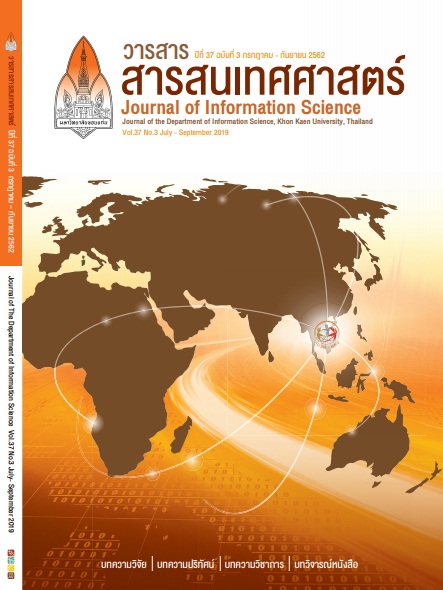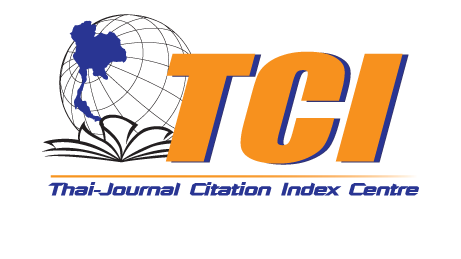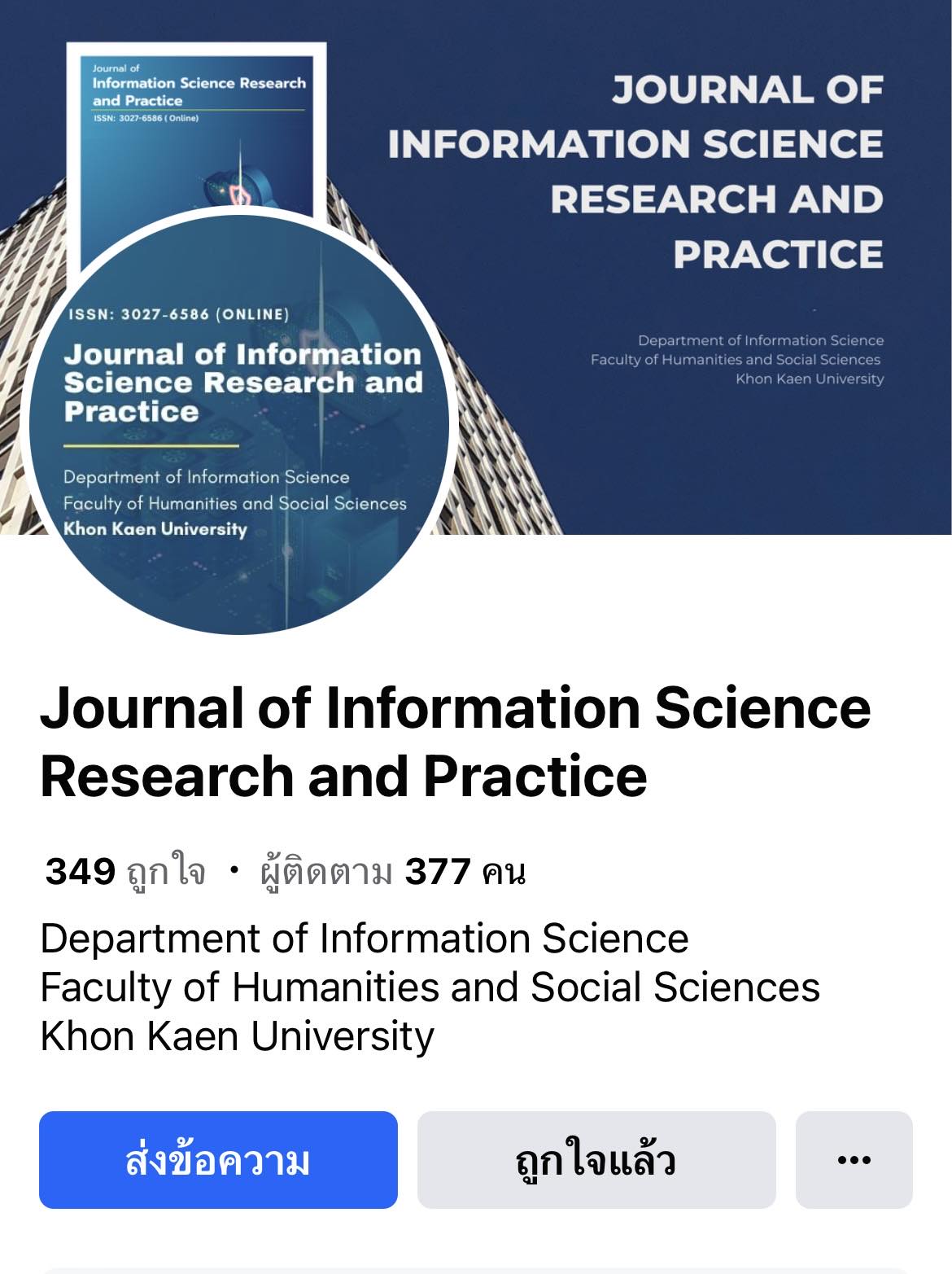Application of Activity-Based Blended Learning Approach in Information Studies Education
DOI:
https://doi.org/10.14456/jiskku.2020.15Keywords:
Activity-based learning, Activity-based blended learning, Blended learning, 21st century skills, Information studiesAbstract
Purpose of the study: This research aims to propose an activity-based blended learning approach to enhance the students' skills of the 21st century within the context of Information Studies.
Methodology: The Research and Development approach is divided into two stages: related research paper synthesis and expert interview are undertaken.
Main findings: The finding showed that the learning approach is appropriate and can be implemented in teaching and learning. The activity-based blended learning approach that consists of 5 main components: 1) Learning activities 2) Instructor 3) Blended-learning environment; 4) Information sources; and 5) Assessment. In addition, there are 3 main steps in this approach: 1) Knowledge 2) Activities learning for experiences and 3) Reflection
Applications of this study: This approach can serve as guideline in the future development of active learning strategies to enhance the students' skills of the 21st century.
Downloads
References
Awasthi, D. (2014). Activity-based learning methodology can bring improvement in quality of education in India, Research paper of GLRA-Global. Journal for Research Analysis, 3.
Bhan, S. (2014). Activity based learning in commerce and tourism education. African Journal of Hospitality, tourism and Leisure, 3(2): 1-8.
Buathong, S. (2017). Measurement and assessment of learning skills in the 21st century Veridian E-Journal,Silpakorn University, 10(2): 1856-1867.
Çelik, H. C. (2018). The Effects of activity based learning on sixth grade students’ Achievement and Attitudes towards Mathematics Activities. Eurasia journal of mathematics, science and technology education, 14, 1963-1977.
Chapaeva, N. K., Akimovaa, O. B., Selivanova, A. V., & Shaforostovaa, T. V. (2016). The activity based approach to achieving theoretical and practical consensus in pedagogy of N. F. Talyzina. International Journal of Environment & Science Education, 11(16): 8821-8833.
Churchill, D. (2004). Effective design principles for activity-based learning: The crucial role of learning objects in Science and Engineering education. Retrieved from https://www.semanticscholar.org/paper/EFFECTIVE-DESIGN-PRINCIPLES-FOR-ACTIVITY-BASED-%3A-OF-hurchill/9127b37c0198937227a474bbc27541aa7904aa19
Eriyagama. (2018) Activity-based teaching methods for better learning in primary mathematics classrooms. World Voices Nexus, The WCCES Chronicle, 2(2), Retrieve from https://www.worldcces.org/article-3-by-eriyagama/useof-activity-based-teaching-methods-to-create-peaceful-learning-in-primarymathematics-classrooms
Faculty staff of Library and Information Science program. (2012). The Study on the Needs of Graduate Students in Library and Information Science Program. (in Thai). Retrieve from http://human.dusit.ac.th/document/manual/2555/curi_lib_research.pdf
Festus, A. B. (2013). Activity-based learning strategies in the Mathematics classrooms. Journal of Education and Practice, 4(13), 8-14.
Golji, G. G., & Dangpe, A. K. (2016). Activity–based learning strategies (ABLS) as best practice for secondary Mathematics teaching and learning. The Journal of Teaching and Learning, 2, 106-116.
Lijanporn, S. (2014). The development of an activity-based learning model using educational mobile application to enhance discipline of upper elementary school students. OJED, 9(4): 13-26.
Lippman, P. (2016). Activity based learning environments. Retrieved from https://placescreatedforlearning.com/activity-based-learning-environments
The Partnership for 21st Century. (2019). Framework for 21st century learning definitions. Retrieved from https://www.battelleforkids.org/learning-hub/learning-hub-item/framework-for-21st-century-learning-definitions
McGrath, J. R. and MacEwan, G. (2011). Linking pedagogical of activity-based teaching. The International Journal of Interdisciplinary Social Sciences,6: 261-274.
Ministry of Education. (2010). Activity-based learning. (in Thai). Retrieved from https://www.moe.go.th/moe/th/news/detail.php?NewsID=16207&Key=news15
Na Songkhla, J. (2007). E-Instructional design. Bangkok: Centre for Educational Innovation, Print and Online Media, Faculty of Education, Chulalongkorn University.
Namdej, N. (2014). Blended learning for nursing students. Journal of Phrapokklao Nursing College, 25(2): 85-94.
National Council of Educational Research and Training. (2011). Activity based learning, Tamil Nadu: Programme evaluation report. Retrieved from https://eppi.ioe.ac.uk/cms/Portals/0/PDF%20reviews%20and%20summaries/Pedagogy%202013%20Westbrook%20report.pdf?ver=2014-04-24-121331-867
Office of Higher Education Commission. (2011). OHEC prepares to produce Thai graduates in the 21st century. (in Thai). OHEC Newsletter, 2(74), 1-5.
Office of the Basic Education Commission. (2017?). Guideline for learning activity: Reducing classroom hours and more time to learn. (in Thai). Bangkok: Office of the Basic Education Commission.
Pakdeewichit, Y. (2014). Active learning and 21st century skills learning. (in Thai). Nakhon Sawan: Nakhon Sawan Rajabhat University.
Patil, U., Budihal, S. V., Siddamal, S. V. and Mudenagudi, U. (2016) Activity based teaching learning: An experience. Journal of Engineering Education Transformations, Retrieve from https://www.researchgate.net/publication/289686417
Phornphatcharaphong, W. (2017). Need assessment for Information Science graduate student in 21st Century. Journal of Humanities and Social Sciences, MSU, 36(5): 151-161.
Priyono, W. & Rahardjo, B. (2017). Using activity-based learning approach to enhance the quality of instruction in civil engineering in Indonesian universities. AIP Conference Proceedings, 1887(1) Retrieved from 10.1063/1.5003491https://aip.scitation.org/doi/10.1063/1.5003491
Ruckbumrung, T. (2012). Blended learning. (in Thai.). Journal of Education Rajabhat Maha Sarakhma University, 9(1): 31-40.
Salo, P. (2017). Needs to strengthen 21st century skills of high school students in Bangkok metropolitan area1. Veridian E-Journal,Silpakorn University, 10(3): 785-799.
Shah, I., & Rahat, T. (2014). Effect of activity based teaching method in Science. Retrieved from https://www.semanticscholar.org/paper/Effect-of-Activity-Based-Teaching-Method-in-Science-Shah- Rahat/3edd5e771e3605ab8160db32686e39405b9676ca
Suwannatthachote, P. (2014). The design of blended learning with social network technology for increasing student engagement. In Educational Technology: innovative blended learning approach. (in Thai). Bangkok:Chulalongkorn University Press
Thaewanarumitkul, P. (2017). Active learning techniques for creative learning. Retrieved from https://wbsc.dusit.ac.th/mod/forum/discuss.php?d=505
Thanormchayathawat, B., Vanitsuppavong, P., Niemted, W. & Portjanatanti, N. (2016). 21st century skills: A challenge for student development. The Southern College Network Journal of Nursing and Public Health, 3(2): 208-222.
Tsai, M., Shen, P., Chen, W.Y., Hsu, L.C., & Tsai, C. (2019). Exploring the effects of web-mediated activity-based learning and meaningful learning on improving students’ learning effects, learning engagement, and academic motivation. Universal Access in the Information Society, 1-16.
Turner, K., Rakkwamsuk, S, Ruanjaiman, J, Sukgaroen, J. & Suriyanimiitsuk, T. (2016).The pedagogical situation fostering 21st century skills of Nursing students at Boromarajonani College of Nursing, Chon Buri. Nursing Journal of the Ministry of Public Health, 26(2): 128-141.
Vongkamjan, V., & Eungpuang, A. (2017). Academic management enhancing students, learning skills in 21st century of the schools under the Office of Secondary Educational Service Area 24. Journal of Education Graduate Studies Research, KKU, 11(3): 224-233.
Wanpiroon, P. (2011). Blended learning: Principles into practice. Journal of Vocational and Technical Education, 1(2), 43-49.








